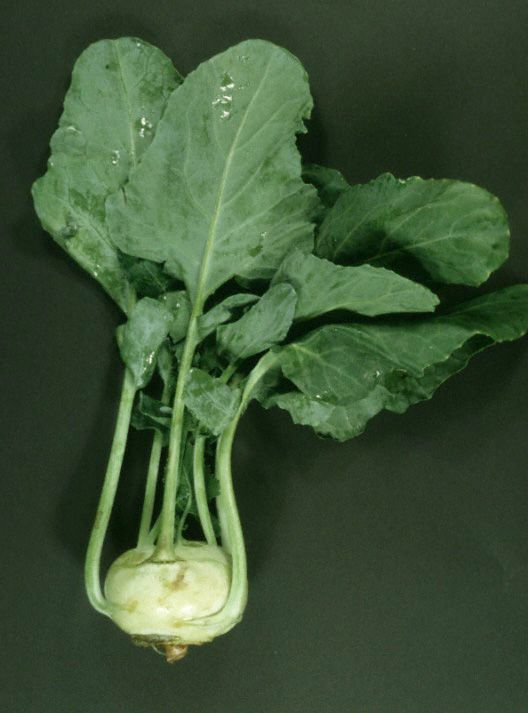 Kohlrabi is a member of the cabbage (crucifer or mustard) family. The edible part is the enlarged stem or bulb above ground from which leaves develop. Kohlrabi may be white, green or purple. Leaves of young plants may be used like spinach or mustard greens.
Kohlrabi is a member of the cabbage (crucifer or mustard) family. The edible part is the enlarged stem or bulb above ground from which leaves develop. Kohlrabi may be white, green or purple. Leaves of young plants may be used like spinach or mustard greens.
Month to Month Care for Kohlrabi
Month of January
This cool-season cole crop produces a turnip-flavored swollen stem in as little as 6 weeks. Six to eight plants are enough for learning whether you like it. It comes green or purple but the inside is always white.
Month of February
Prefers well-drained, fertile soil high in organic matter, pH 6.0 to 7.5. Can tolerate slightly alkaline soil. This heavy feeder also needs plentiful, consistent moisture.
Month of March
If you want to use seeds instead of seedlings from the garden center, start seeds indoors six to eight weeks before the last frost date.
Month of April
Seedlings should be at least four weeks old and have two to four leaves and a stem half as thick as a pencil. Plant them about two to three weeks before the expected last frost date for your area. Mix slow-acting granular fertilizer into the soil when you prepare the planting area. Dig holes in the planting bed about 12 inches apart.
While they can handle cool weather, it is best to protect them from a surprise late frost. Be prepared to cover the tender plants temporarily with white polyspun garden fleece, newspaper cloches, or a cold frame. They also do well in Walls O Water plant protectors.
Kohlrabi likes to have 2 to 3 inches of organic mulch to help keep moisture in the soil.
Optional - consider feeding the plants with liquid fertilizer about three weeks after planting.
Month of June
This plant likes about 1 inch of water a week.
Kohlrabi will keep fresh in the refrigerator in a plastic bag for up to two weeks.
Optional - If temperatures reach the 80’s before you harvest all your Kohlrabi, spread shade cloth over the Kohlrabi plants to keep them a bit cooler and encourage more growth.
Optional Fall Crop - Plan to start harvesting at least a month before killing frost in your area, so start new seedlings right in the garden in late June or early July. Make sure to place the seeds ¼ to ½ inch deep into the soil about two to five inches apart if planting seeds directly outside. Actually kohlrabi tastes better in the fall after a frost than it does in the spring.
Month of July
If eating raw, peel kohlrabi root to expose the white inner flesh, then cut as desired. It is great shredded into a salad.
If eating cooked, wait to peel until after cooking. Bake in a covered dish with a few tablespoons of liquid at 350F / 180C, 50-60 minutes. Covered with light cheese sauce is wonderful. Boil covered, 30-35 minutes. Microwave whole trimmed kohlrabies in covered dish with a few tablespoons of liquid, 6-9 minutes. Sauté shredded peeled kohlrabi; first sprinkle with salt and let sit 30 minutes, then squeeze water out.
Optional - Using shade cloth over the seedlings in the first 6 to 8 weeks helps produce stronger plants in the fall.
Month of August
Don’t forget to mulch the new seedlings once they are 5 or 6 inches tall.
Month of September
You want to make sure to keep the soil well watered or you will end up with woody stemmed plants that are too tough.
Month of October
Long after hardy Swiss Chard succumbs to the cold and freezes of late autumn, the hardy Kohlrabi lives on. A little snow is of little worry for this hardy plant. If the weather is expected to go into the low twenties, you can cover any remaining plants for a day or two until the temperature inches up a bit.
Month of November
Mature kohlrabi withstand even severe frosts--indeed, the plant can be left in the ground right through winter--but young plants may bolt if they see, say, a week of temperatures at or below 50°F. (daily highs, that is).

